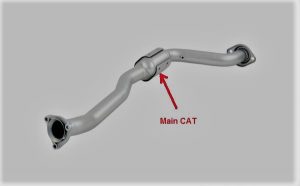The Catalyst Monitor is a key part of the On-Board Diagnostics II (OBD-II) system. This component would ensure that vehicles meet national and/or regional emissions standards. Its job is to check and monitor how well your catalytic converter is working and make sure the emission control system is working right. We’d discuss the Catalyst Monitor’s purpose, its parts, how it works, diagnostic trouble codes(DTCs), and how important it is to keep this system well-maintained below.
Purpose of Catalyst Monitor

The main job of the Catalyst Monitor is to check how well the catalytic converter, the key part of the system to control emissions, is working. The catalytic converter is in charge of cutting down on harmful emissions from the engine, such as hydrocarbons, carbon monoxide, nitrogen oxides, etc. If the catalytic converter isn’t working right, these destructive hazardous fumes can get out into the environment. This makes the air dirty and can hurt your health.
The Catalyst Monitor checks the oxygen (O2) sensors, the air/fuel ratio (A/F) sensors and the exhaust gas temperature (EGT) sensors to make sure the catalytic converter is working well. It looks at the information from these sensors to see if the catalytic converter is working properly. If it finds problems in either the emission control system or catalytic converter, it will set off a DTC or error code.
Catalyst Monitor System Components
The Catalyst Monitor system is made up of several parts that work together to check the efficiency of your vehicle’s catalytic converter. Among these parts are the following:
Engine Control Module (ECM): The ECM is the “Brainware” of the engine. It controls things like the air/fuel mixture, the timing of the ignition, and the emissions control system. It gets information from the O2 sensors, the A/F sensors, and the EGT sensors about how well the catalytic converter is working.
Oxygen (O2) Sensors: your vehicle has at least a couple of O2 sensors that measure the amount of oxygen in the exhaust system and transmit data/signal/information to the ECM. The ECM utilizes this data to change the amount of air and fuel in the engine to ensure the catalytic converter works well.
Air/Fuel Ratio (A/F) Sensors: These sensors detect and measure the amount of air and fuel in the exhaust system and send signals to the ECM. The ECM utilizes this data to change the amount of air and fuel in the engine to ensure the catalytic converter works properly(improve efficiency).
Exhaust Gas Temperature (EGT) Sensors: These sensors detect and measure how hot the exhaust gases are and send signals to the ECM. The ECM uses this data to keep track of how well the catalytic converter is working.
Catalyst Monitor System Operation

The Catalyst Monitor system would analyze data sent by the previously mentioned sensors. The ECM uses this information to figure out how well the catalytic converter is working. It checks how well the catalytic converter works by comparing the oxygen level before and after the converter. If the catalytic converter works right, it will lower the amount of oxygen in the exhaust gas. If it isn’t working right, the same amount of oxygen will be in the exhaust gas prior to and following the catalytic converter.
Catalyst Monitor Diagnostic Trouble Codes (DTCs)
If the Catalyst Monitor system finds issues with the catalytic converter and/or the emission control system, it can set off different DTCs. Some common DTCs that have to do with the Catalyst Monitor are:
- P0420 – Catalyst System Efficiency Below Threshold (Bank 1)
- P0421 – Warm-Up Catalyst Efficiency Below Threshold (Bank 1)
- P0422 – Main Catalyst Efficiency Below Threshold (Bank 1)
- P0423 – Heated Catalyst Efficiency Below Threshold (Bank 1)
- P0430 – Catalyst System Efficiency Below Threshold (Bank 2)
- P0431 – Warm-Up Catalyst Efficiency Below Threshold (Bank 2)
- P0432 – Main Catalyst Efficiency Below Threshold (Bank 2)
- P0423 – Heated Catalyst Efficiency Below Threshold (Bank 2)
If you get any of these DTCs, it means that the catalytic converter and/or the emission control system isn’t working right. It is important to figure out what these DTCs mean and fix them right away to make sure your car meets emissions standards and doesn’t hurt the environment.
First, check the O2 sensors, A/F sensors, and EGT sensors to figure out what’s wrong and fix it. Whenever issues are detected by these sensors, the Catalyst Monitor will send out a DTC. You should also check to see if the catalytic converter is broken or clogged. If the catalytic converter is broken or clogged, it won’t work well and will need to be replaced.
If you don’t know how to figure out what’s wrong with your car or how to fix it, you should ask a professional mechanic for help. They will know how to figure out what’s wrong with the Catalyst Monitor system in your vehicle and fix it.
Importance of Maintaining Catalyst Monitor System
The Catalyst Monitor system in your car needs to be taken care of for some reasons. First, it makes sure that your car meets the required benchmark for emissions and isn’t excessively polluting the environment. Second, it makes sure that your car runs well, doesn’t waste gas, and doesn’t damage the engine.
Follow the maintenance schedule suggested by the car’s manufacturer to keep the Catalyst Monitor system in good shape. This means that the catalytic converter and those sensors in the system(O2,EGT, A/F) need to be checked often. You should also have the ECM of your car checked regularly to make sure it is working right.
In addition to keeping up with regular maintenance, as a driver, you should embrace an efficient driving style. This means avoiding rough driving, speeding up slowly, and keeping a steady speed. Don’t overload your vehicle because it would put more stress on the catalytic converter and consequently elevate emission levels.
Consequences of Ignoring Catalyst Monitor System Maintenance
If you don’t take care of your car’s Catalyst Monitor system, you’d likely run into a number of problems. First, your car may fail emissions tests, which can lead to fines and other penalties. Second, your car might not run well, which can cause your gas mileage to go down and engine damage. In the end, you may have to pay a lot to fix or replace the catalytic converter and/or other components of the system.
Neglecting Catalyst Monitoring system maintenance would also be bad for the environment because it can cause harmful pollutants to be released into the air. These pollutants can add to air pollution, and this can be bad for your health and lead to things like breathing problems and heart disease. At this point, even starting your vehicle in the garage could be hazardous.
Conclusion
The OBD-II Catalyst Monitor checks emissions. It checks the emission control system, catalytic converter efficiency, and failures. Follow the manufacturer’s maintenance schedule and drive efficiently to maintain your Catalyst Monitor system. Doing so ensures your vehicle meets emissions regulations, runs effectively, and is more environmentally friendly.

As a mechanical engineer, it’s easy for David to explain the functionality of the tool. David test most of the tools before writing a review. its help him to learn something new and suggest the best product for you.





